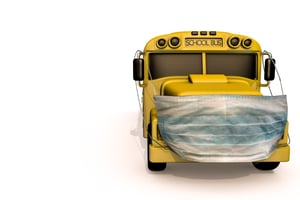Safely Disinfecting School Buses
published on February 17, 2021 by Sonia Mastros
Student Transportation, electric school buses, Student School Bus Safety, school bus cleaning
 For as long as the COVID-19 coronavirus outbreak lasts, it's going to be absolutely vital to keep your school buses clean and sanitized. Buses will always be a high-risk area for transmission, so they call for high levels of diligence. Parents need to feel safe when putting their children on your buses!
For as long as the COVID-19 coronavirus outbreak lasts, it's going to be absolutely vital to keep your school buses clean and sanitized. Buses will always be a high-risk area for transmission, so they call for high levels of diligence. Parents need to feel safe when putting their children on your buses!
Here are some important tips to help ensure your buses are as sanitary as possible for every trip
Important Do's and Don'ts When Disinfecting Your School Buses
1. DO Sanitize Your Buses After Every Trip
Cleaning and disinfecting buses must now be part of the routine post-trip procedure every time. If anyone has been onboard, even just the driver, there's a chance of contamination. The only way to reduce the risk is through frequent cleaning.
2. DON'T Disinfect Without Cleaning First
Disinfecting agents like alcohol or bleach can only do so much. They should only be applied to surfaces that have already been cleaned using standard methods. Don't try to skip this step or the disinfection won't work.
3. DO Use PPE Whenever Cleaning
Whoever cleans the bus should be wearing as much PPE as is reasonably possible, to avoid contaminating surfaces as they clean. Also, many cleaners and disinfectants are caustic, so gloves and eyewear are called for anyway.
4. DON'T Use Bleach on Fabrics Like Seat Belts
Concentrated bleach can damage fabric, weakening it. This is particularly hazardous when it comes to seat belts since the bleach could potentially compromise them - particularly if the bleaching happens repeatedly.
5. DO Substitute Denatured Alcohol When Needed
Isopropyl alcohol is one of the most effective disinfecting agents, but it can be hard to find due to ongoing medical needs. In a pinch, denatured alcohol works about as well - and it's usually readily available at hardware stores and suppliers.
6. DON'T Use Ammonia on Plastic, Vinyl, or Touchscreens
Ammonia-based cleaners are also highly effective for disinfecting, but ammonia can damage a lot of surfaces on a bus. Plastic, vinyl, and most touchscreens will be harmed if you use ammonia on them. It's particularly important to avoid using ammonia on vinyl, as it actively breaks vinyl down.
7. DO Wipe Down Surfaces Which Are Cleaned With Bleach
Bleach should not be allowed to stand on surfaces since it can cause discoloration or damage. After using bleach to disinfect, wipe the surface with clean water to remove any bleach remaining on the surface.
Finally, consider investing in more high-tech disinfecting solutions such as foggers or high-powered UV light systems. These cost a bit but can save you a lot of money in the long run by substantially reduce the effort needed to sanitize your buses.
Do you have any good tips for disinfecting your school buses? Please share them in the comments below!






